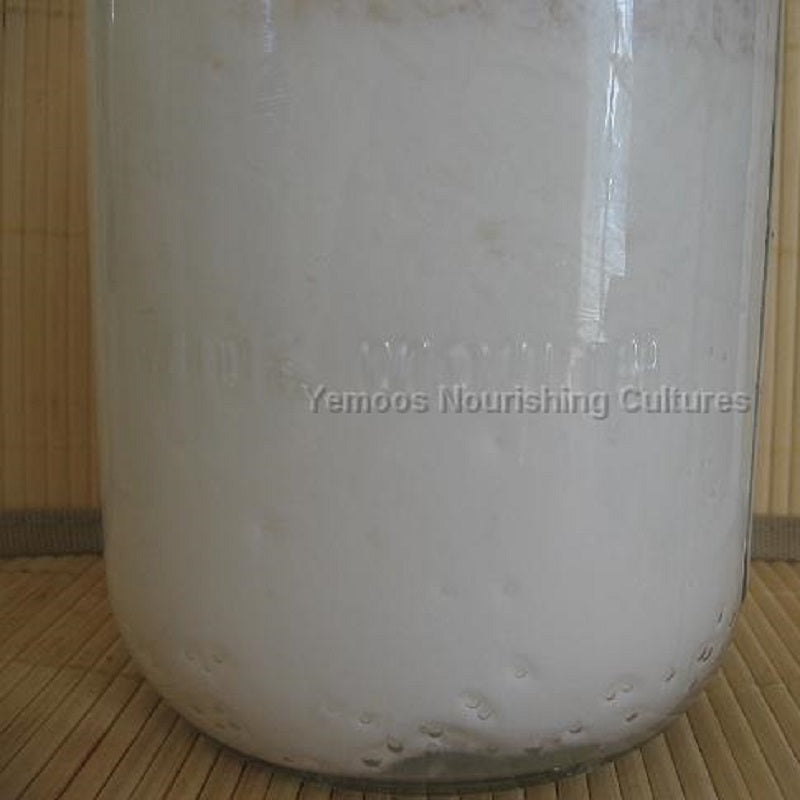
Generally most people desire to keep their milk kefir bacteria rich instead of yeasty. The yeast is responsible for the effervescent and multi-dimensional qualities, so its definitely important, but too much and its becomes less appealing.
Yeasty kefir will ferment fast, fizzy and thin.

Milk kefir has a tendency to slowly shift towards the yeast if its not under ideal conditions. But there are ways to help shift the balance in favor of the bacteria.
1. Use Raw Milk
Raw milk is filled with good bacteria (and enzymes) and that means its very hard for the yeast to take over no matter what you do. I've never seen raw milk kefir go the yeasty route. It's the most fool proof way to keep it bacteria rich, slow and usually thick. Granted that in many states and countries, it is very different to locate a good quality raw milk. Raw milk kefir is best, but pasteurized milk kefir is still a very healthy alternative. So if you go the pasteurized route there are still ways to keep it as bacteria rich as possible by following the rest of the list.
2. Ferment Colder
Try consistently fermenting the kefir at 65-70 degrees. The slightly cooler temperatures favor a slower more bacteria rich ferment.
Avoid temperatures below 65 if possible as it can sometimes cause an improper ferment.
Also avoid temperature fluctuations. Fluctuations stress out the kefir and when the grains get stressed, the yeast tends to take over as the yeast is faster and more opportunistic than the bacteria.
3. Use more milk
Over-fermentation can stress out the grains and any stress can lead to yeasty grains. Using more milk will help naturally balance the grains. The yeast tends to be faster and more opportunistic, so if there's not enough milk, it can steal the needed nutrients and sugars and not leave much for the bacteria to thrive on. With plenty of milk, there should be enough for both the bacteria and yeast.
4. Ferment longer than 24 hours
Grains can adapt to longer schedules and this will ultimately help the bacteria. If you do consistent 48-72 hour batches, It will adapt to this new schedule and will ferment slower, more bacteria rich and many times thicker. Longer ferments naturally help the bacteria as it tends to be slower than the yeast and it takes time for the bacteria to catch up to the yeast. If you are continually doing short ferments, the yeast can sometimes continually have the upper hand.
5. Bury the grains in yogurt technique

Simply bury the grains in a jar of plain yogurt for a few days in the fridge. The idea behind this technique is that yogurt is rich in bacteria with little to no yeast and that environment will help shift the balance from yeasty to bacteria rich. I've heard mixed results from this technique. Sometimes it works great, but may not be aggressive enough if the grains are really yeasty.
6. Occasional long ferment technique
This technique tends to help to some degree and can be done multiple times for better results. Basically the idea is to do the occasional 2-3 day ferment and it will naturally over-ferment, but in that environment the bacteria has a chance to catch up to the yeast and the yeast tends to calm down a bit. When you go back to the regular 24 hour schedule, it tends to be slower and more bacteria rich. I've seen grains that refused to grow because of the yeasty environment, start growing again after doing this technique. You can do this technique a couple times, but its best not to continually over-ferment them as that will stress them out.
7. Fridge Ferment
Ferment exclusively in your fridge to help calm the yeast and keep it bacteria rich. It takes about a week but can vary with different fridge temperatures. Most people notice that its gets thicker too. Sometimes if the grains are really yeasty, it can stay that way even in the fridge. One aggressive trick is to give the grains a really good rinse and then ferment in the fridge.
8. Aggressive rinsing and resting
This technique should only be done as a last resort. The aggressive rinsing and resting will rinse away beneficial surface bacteria and yeast that the grains will have to rebuild which can take several batches. Basically you simply rinse the grains really well in unchlorinated water and leave them in in fresh unchlorinated water for 2-3 days. A less aggressive form on this technique is to let them rest in milk for 2-3 days.



Comments
Marilyn
This is exactly what I needed, thanks!
I got some grains locally recently, & they are pretty yeasty.
Found out my supplier uses ultra pastuerized milk, ferments until milk separates, & the grains he gave me were in the fridge without milk. But maybe he just strained them before I arrived to pick them up.
Now I know what to try. 😊
June 08, 2022
Vicky Hidalgo
Hi!
Some of my kefir batches aferre I strained them, air locked them and put it in the fridge for 5 days become very fitzy and when I shake and open the bottles the kefir comes outing out .
Does this means I have more yeast also? Can it make me sick if I drink it?
Other grains and kefir don’t do this. But this particular batch can’t seem to go back to “normal” for me.
The fermentation is 24 hours , 21 C degrees, whole UTH milk.
Thanks!
July 12, 2021
Yemoos Nourishing Cultures
Hi Enrique – Getting yeastier kefir is fairly easy. If it was in the fridge for awhile, a few batches naturally makes it more yeasty. A cloth lid / open lid helps. Warm, but not too hot helps as well. Shorter batches usually gets the yeast quite happy. Do 12-18 hour ferments to help speed up the yeast. If you feel adventurous try adding a tiny bit of molasses to the ferment as that should get the yeast going strong.
April 30, 2020
Enrique
What if I want to make it MORE yeasty? I had my grains in my fridge for a couple of weeks and now the resulting product is very bacteria rich but not fizzy enough for my taste.
Should I leave the jar lid ajar? Just cloth? Higher temp?
April 30, 2020
Yemoos Nourishing Cultures
Hi Liz,
You can ferment in the fridge long term, but you may run into balance or growth issues after too much fridge use. The most common issue is that it simply stops growing and even room temperature ferments won’t kick-start the process. If you want to take a long break from milk kefir, try freezing instead of drying. The drying process is pretty harsh on milk kefir grains. Simply coat the grains in dried milk powder and store in the freezer for any long term storage.
February 13, 2020
Liz
Part of the reason for my first question is that I want to take a long break from making kefir regularly. I know one way to do this is to dehydrate the grains. My grains have been in the fridge for a few weeks already. Can I dehydrate them now or do I need to wake them up a little first?
February 12, 2020
Liz
How long can I ferment exclusively in the fridge? In other words, can I do consecutive one-week ferments for, say, 12 weeks?
February 12, 2020
Yemoos Nourishing Cultures
Hi Ginny – After a yogurt bath, a simple strain is usually enough. Or you can do a light rinse with milk if desired.
November 14, 2019
Ginny
soaking my grains in full fat yogurt at this time. Do I rinse the yogurt off? With water/milk? Hate the yeasty smell and taste.
November 14, 2019
Elaine Hauck
To ensure my milk kefir grains have two specific lactobacillus strains I want, can I add capsules of those probiotics to the grains and milk while it is fermenting and will the grains absorb those strains and reproduce them with each fermenting, going forward? If so, does it need to be done multiple times to ensure enough of the strains get absorbed or will one time be sufficient. Thank you.
October 20, 2019
Leave a comment